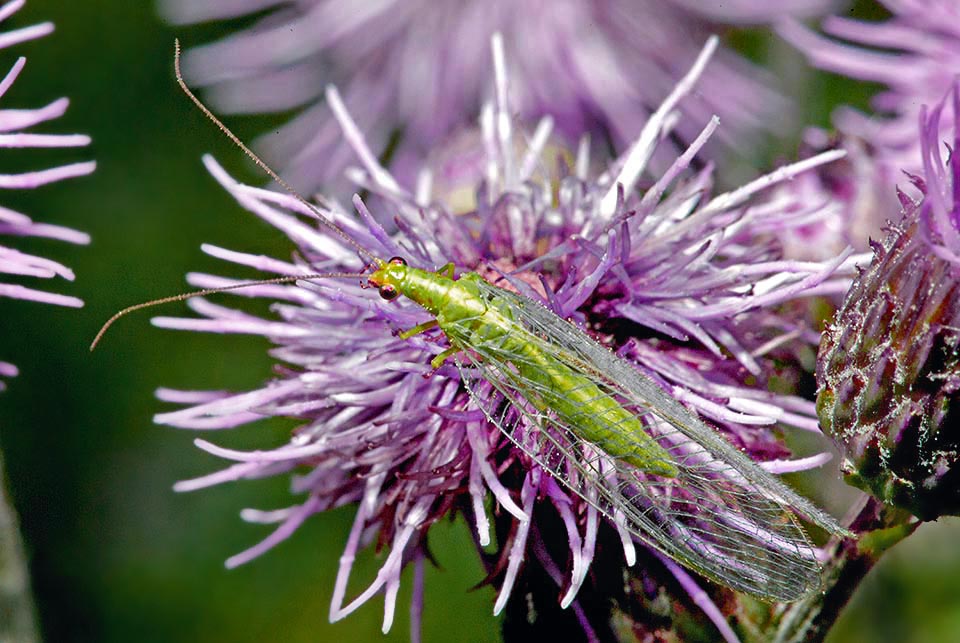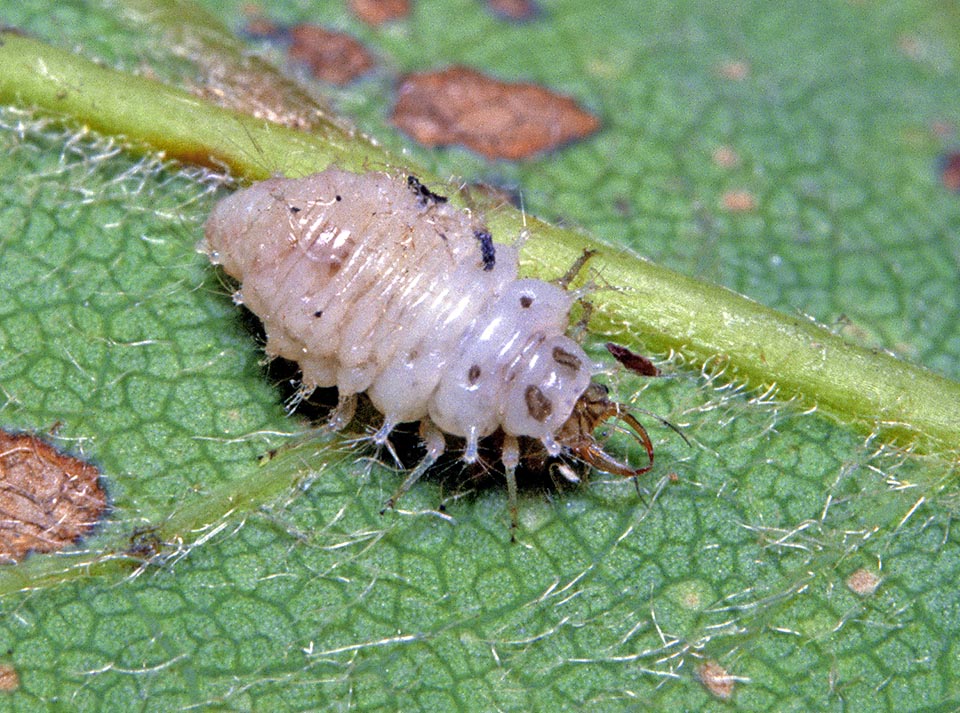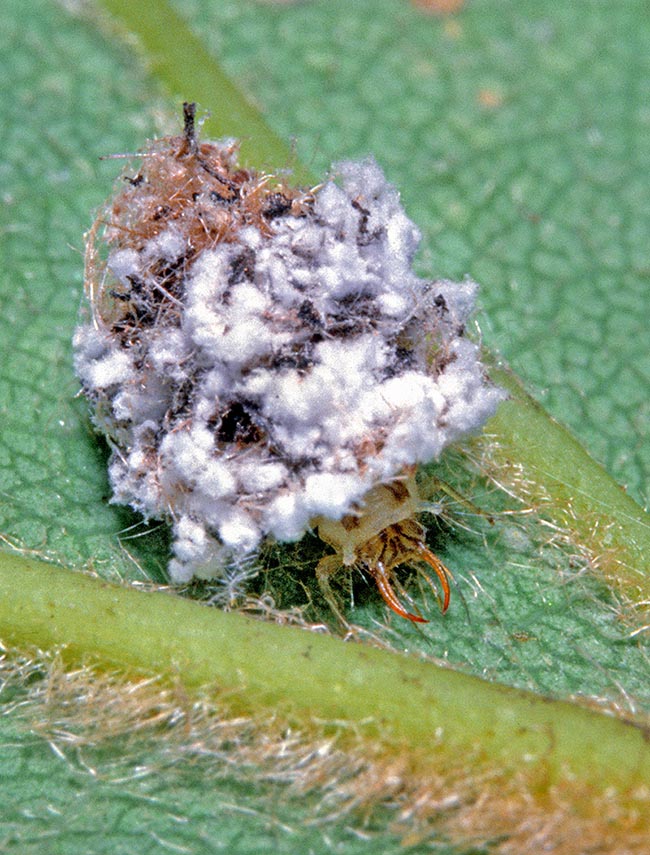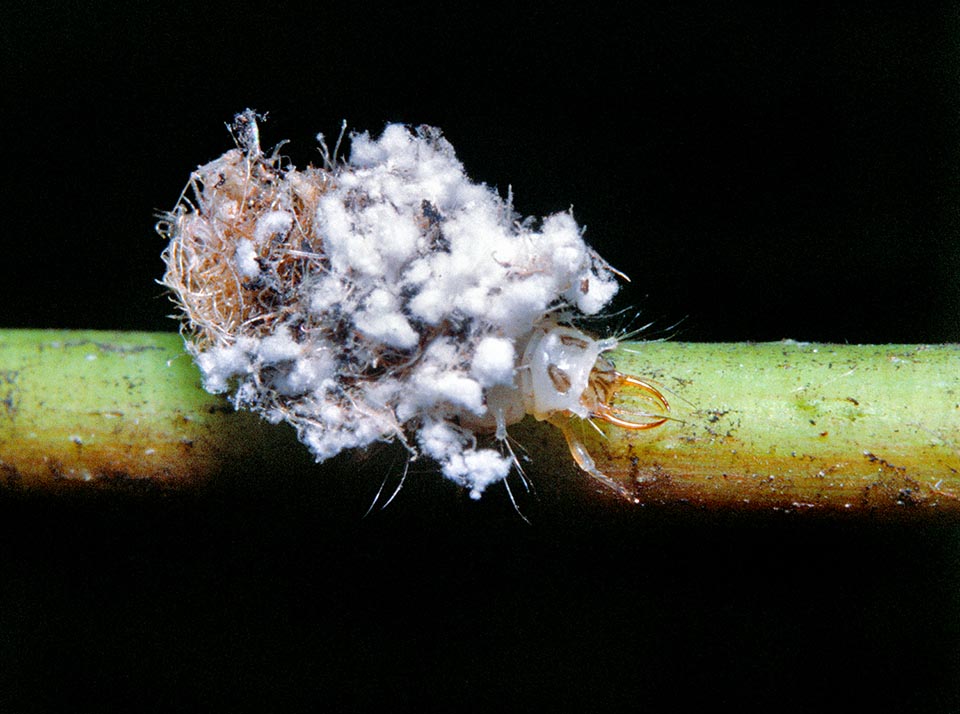Family : Chrysopidae

Text © Prof. Santi Longo

English translation by Mario Beltramini

Chrysotropia ciliate is a Neuropter present in west and central Europe, in Middle East and in central-eastern Asia © Giuseppe Mazza
Chrysotropia ciliata (Wesmael, 1841) belongs to the order Neuroptera that counts about 4500 species subdivided in the three orders Megaloptera, Rhaphidioptera and Planipennia.
To the last suborder belongs the family Chrysopidae that includes about 40 genera.
The adults of this family have a medium sized body with delicate tegument of colour varying from yellow to green. The head, called hypogned, is facing down. The antennae are filiform, the mouthpart is of masticatory type. The eyes, of reduced dimensions, are prominent with metallic reflections. The wings are developed, transparent with iridescent reflections, rich in veins.
The larvae are campodeiform due to their resemblance with the adults of the Diplura, primitive hexapods of the genus Campodea. The body is depressed and has ambulatory legs.

A bare larva looking for preys. Like adults, it’s a gredy devourer of cottony scale insects: species infesting beeches and several ornamental or fruit plants © Giuseppe Mazza
The mouthpart is pungent sucking, shaped like a forceps. With this, the insect blocks the prey and injects into it the digestive secretions that liquefy the tissues, allowing their suction. The upper part of the body has numerous integumental reliefs. Some species mimetize putting on their own body the exuviae of the preys.
The mature larvae weave a cocoon with the silk secreted by their secretory organs, homologous to the kidneys, called Malpighian tubules. Before the adults’ flickering, the pupae abandon the cocoon.
The generic name Chrysotropia is composed by the old Greek “χρυσός” (chrysós), gold, and by “τροπία” (tropìa), to change, to transform with reference to the changes in colours of the wings depending on the inclination of the light. The specific term ciliata, with the eyelashes in Latin, is a clear reference to the eyelashes present on the wings.

The remains of the victims and the waxy ovisacs are then placed by the larva to protect the body to camouflage among the preys and escape attention of the ants protecting actively their cochineals producers of honeydew © Giuseppe Mazza
Zoogeography
Chrysotropia ciliata is reported in western and central Europe, in the Middle East and in central-eastern Asia.
The Chrysotropia ciliata at the larval stage as well as adult, is an active predator of cottony mealybugs: and is often present on various arboreal species such as the beeches infested by the Beech scale Cryptococcus fagisuga, as well as on fruit and ornamental plants infested by Pseudococcids belonging to genera Planococcus, Pseudococcus, etc.
The bodies of the victims emptied of the tissues and especially the waxy ovisacs are placed by the larva as protection of its body also for camouflaging and escaping the predating ants that protect the scale insects producing the honeydew.
Morphophysiology
The body of the adults is of green yellowish colour and is averagely 15 mm long.
The males are a little smaller than the females.
The head is whitish with the fore part green yellowish; the mouthpart is of masticatory type.
The eyes, brown, are round; the antennae are very long.
On the first segment of the thorax are present characteristic tubercles.
The legs are of deambulatory type.
The wings of both sexes have the fore margin equipped with long hairs, the length of the females’ wings is of 16 to 17 mm, that of the males is of about 15 mm.
The eggs are green. The larvae have thoracic legs and are called oligopod, of campodeiform type with simple eyes (ocelli).
The mouthpart is, as we have seen in the description of the family, of pungent sucking type with the shape of a forceps formed by the elongated and curved mandibles with a ventral groove to which adapt the jaws.
The pupae have mobile mandibles and a certain capacity of movement, are called decticous. Actually, they are adults in the farata phase, meaning with this term the period going from the moment of the detachment of the old cuticula of the epidermis (apolysis) and the exit of the individual from the exuvia.

The prey is seized with the forceps formed by the long mandibles and sucked after having injected digestive secretions that liquefy the tissues allowing their suction © Giuseppe Mazza
Ethology-Reproductive Biology
The adults are present on the infested plants from April to September. Their number is higher in July and in August, time when the cochineals hosted reach the highest densities of population.
The females, after mating, lay the eggs, single or in small groups close to the colonies of the predated colonies, on the fore pagina of the leaves or branchlets.
The birth of the larvae happens thanks to an egg crusher present in the larval exuvia. The larvae, to escape the predating activity of the ants, mimetize placing on the back the remains of the preys and of their waxy ovisacs. The larval stages are three and the pupae get out from the cocoon just before the flickering.
